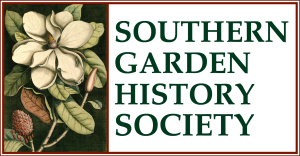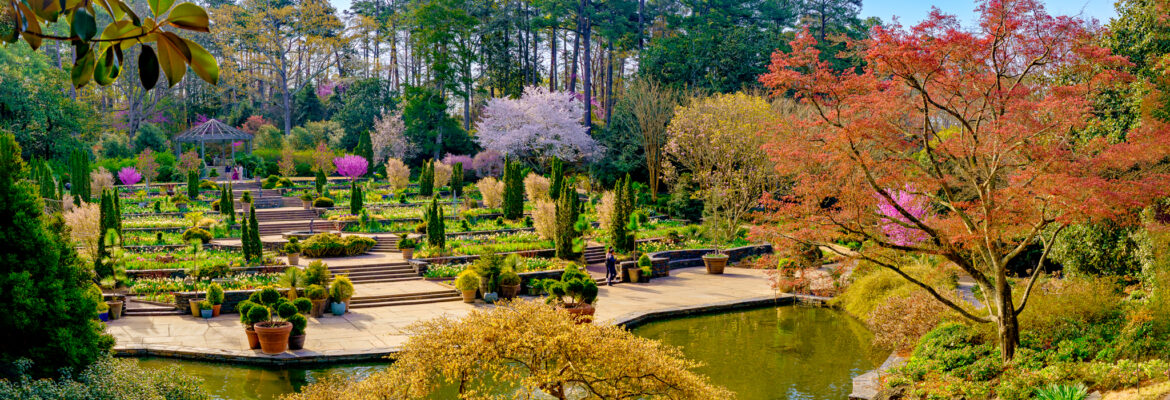
Credit: Kyle Foreman of Kyle Foreman Photography, Durham, N.C.
Growing up only five miles away from the Sarah P. Duke Gardens (SPDG), this writer found the site an easy-to-reach and often-visited destination during his younger days. It was, however, only as an adult and living a bit farther off in Hillsborough (and helping to produce Magnolia) that he became familiar with the connection between SPDG and landscape architect Ellen Biddle Shipman, a name that has come up regularly on the Gardens page. Readers will know, of course, that these gardens have yet to be visited by SGHS. However, discussion by the Society’s board of directors continues about organizing an annual meeting based in the Chapel Hill, Durham, and Raleigh area, a region truly rich with exciting garden-visit possibilities.
Encompassing fifty-five acres with a ravine at its core, this patch of ground forms an integral part of Duke University’s West Campus, widely known for its Collegiate Gothic architecture. My father, who came of age in Durham during the 1920s when West Campus construction was beginning, recalled that the forested SPDG ravine and other similar nearby areas had been used by some city residents as trash dumps, a fact confirmed by several sources discussing SPDG’s early years.
As detailed in the Magnolia article linked below,* the initial support for a garden here came from a leading medical faculty member, Dr. Frederick Hanes. A native of Salem, North Carolina, (becoming half of Winston-Salem in 1913) Hanes joined forces and finances in the early 1930s with Benjamin Duke’s widow, Sarah, to create a garden that chiefly focused on iris cultivation. Although flooding and plant disease soon spelled the doom of his first endeavor, Hanes persevered, now with the support of the deceased Sarah’s daughter and prominent philanthropist, Mary Duke Biddle.
Frederick Hanes and Mary Duke Biddle would then call on Ellen Biddle Shipman to prepare plans for “what would become the oldest and best-known feature of the Duke Gardens.”** The choice of Shipman, in turn, was probably influenced by the previous work she had done in Winston-Salem for Dr. Hanes’ relatives, Ralph and DeWitt Hanes, along with Shipman’s Biddle family links.*** It is Shipman’s creation that survives with particular force in this writer’s memory.
Revealing of her early association with Charles Platt and thus showing the influence of Italian Renaissance design themes, the heart of Shipman’s work centers on a set of terraces leading from a wisteria-covered iron pergola down the southeastern slope of the ravine to level ground below. For the stone necessary for terrace construction (stonework being requisite for any garden grounded in formal Italian basics), builders had access to the same quarry near Hillsborough used to construct the buildings spread about the neighboring campus areas. Water features included pools and fountains set on the terraces, while in the level area below, Shipman’s layout encompassed a large fishpond now home not only to koi but also to a significant collection of water lilies. Varying in shade with the seasons, the terrace area gets color, texture, and verticality from a wide range of perennials, annuals, evergreen shrubs, magnolias, and pines, the gardeners here taking extensive advantage of plants in pots to widen further the range of horticultural display.
For reshaping the slope opposite SPDG’s signature terraces and above the fishpond, Shipman turned for rock garden concepts to New England-based landscape designer Frederic H. Leubuscher. He, in turn, brought in large quantities of weathered New Jersey limestone to the site and then cleverly embedded that material into the hillside to create a naturalistic setting that served as a perfect foil to Shipman’s formal layout. Finely crafted as a stand-alone and shady designed space, the Leubuscher Rock Garden and the Rollins Overlook just above it also offer ideal viewing spots for enjoying the terrace garden from a distance.
While the pergola, terraces, fishpond, and rock garden formed the original Duke Gardens, which were officially opened in 1939, great expansion has taken place in subsequent years. Further significant areas include the nearly seven-acre Blomquist Garden, which includes over 1,200 species of native plants, the eighteen-acre Culberson Asiatic Arboretum, and even an interpretive moss garden, to name but several spots that readers can visit in person or explore via the SPDG website linked below.****
*************************************************************
Note: We wish to thank Durham resident Kyle Foreman, who specializes in landscape and cityscape photography, for the use of his Duke Gardens image. More of his work can be seen at kyleforemanphotography.com.
For a map of SPDG, see: https://gardens.duke.edu/wp-content/uploads/Full-Sarah-P.-Duke-Gardens-Map-for-digital.pdf
*https://southerngardenhistory.org/wp-content/uploads/1993-Winter-Vol.-IX-no.-2.pdf#page=7
**See above cited Magnolia article link.
***Judith Tankard, The Gardens of Ellen Biddle Shipman, 1996, 170.
**** https://gardens.duke.edu/


Leave a Reply